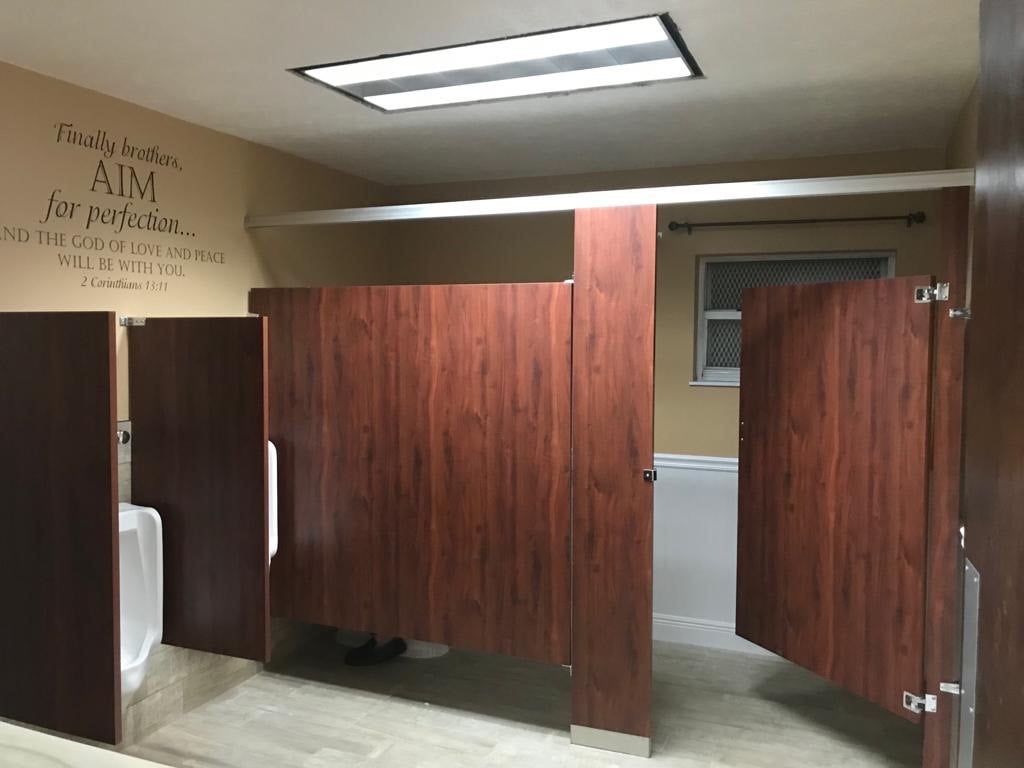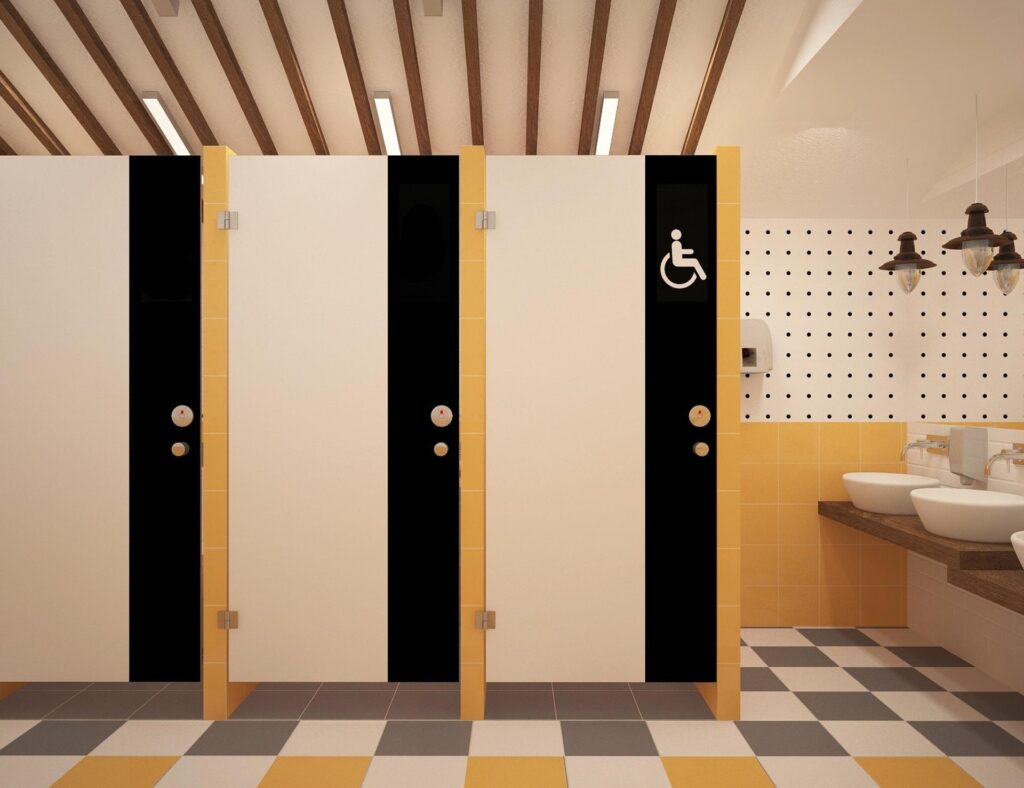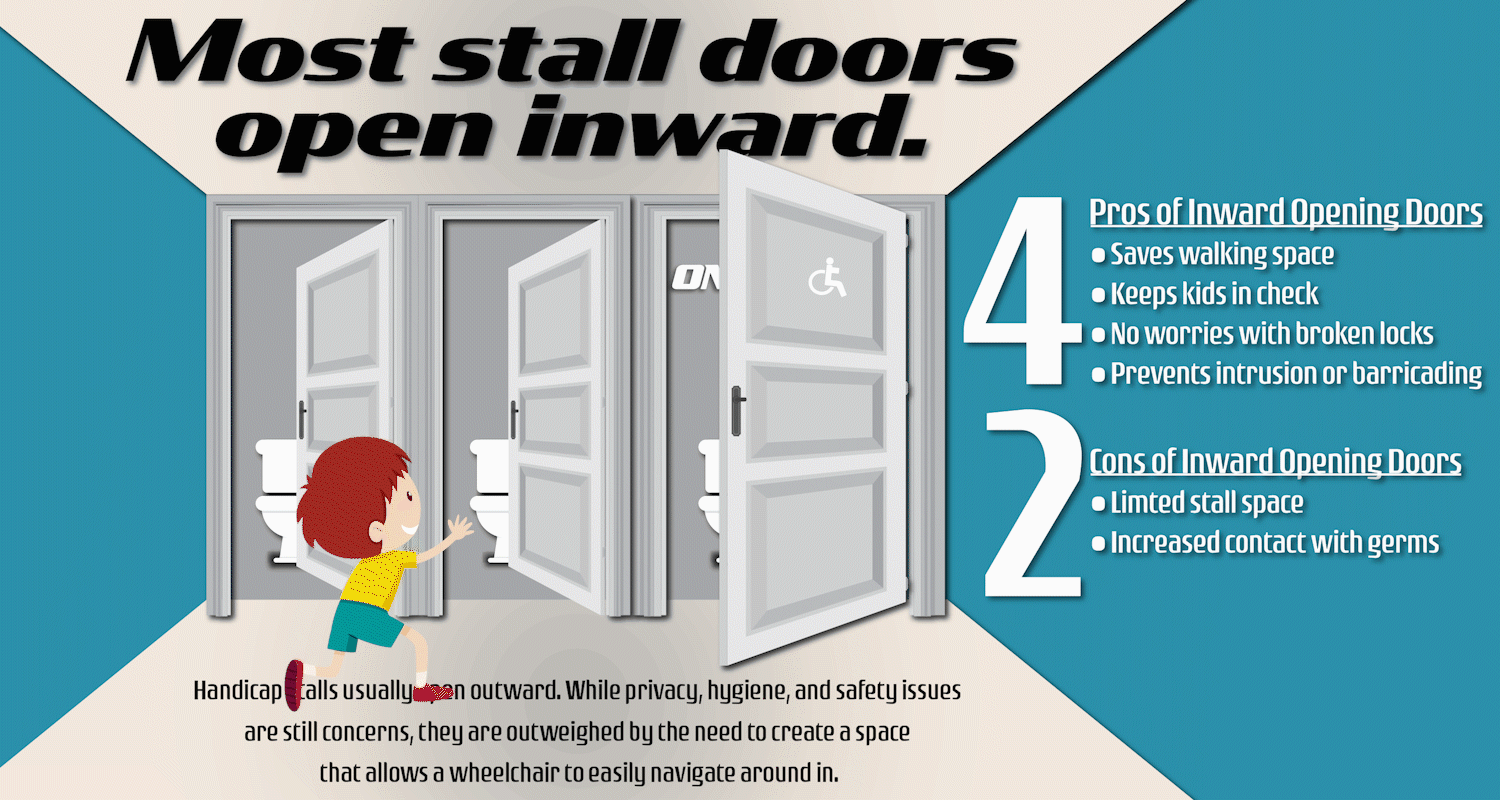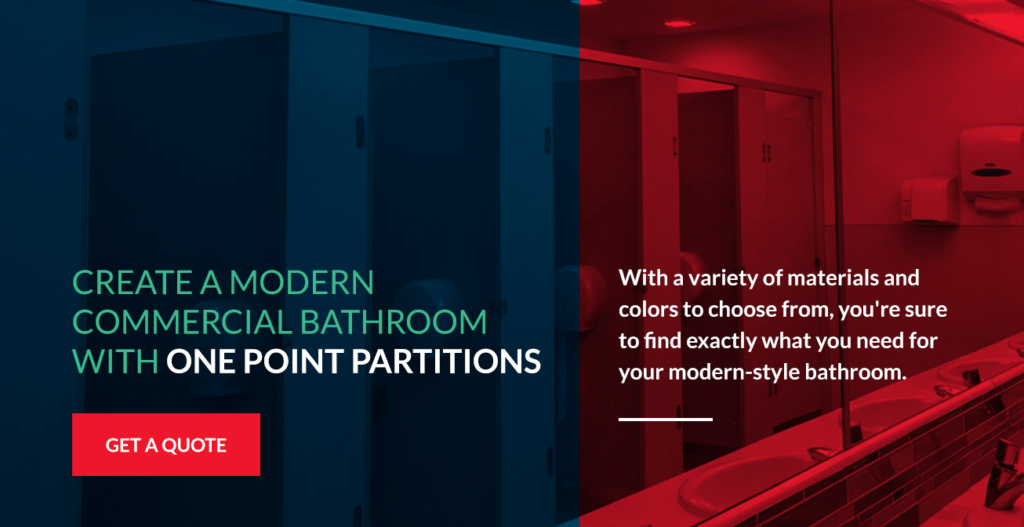Inswing vs Outswing Partition Doors: Which Is Better for Public Bathrooms?

Inswing partition doors open into the stall, while outswing doors open outward. The difference between them seems minor. However, each option uniquely affects space optimization, accessibility, and user experience in commercial bathrooms. They also influence regulatory compliance.
While doors that open inwards are the most common in bathrooms, that doesn’t rule out the benefits of outswing doors. So, which is the best choice for your public restroom?
Why Do Bathroom Partition Doors Usually Swing Inward?
Since inswing partition doors open into the toilet compartments, they save space outside the stalls. They reduce the risk of blocking foot traffic in the bathroom hallway, so people can enter and leave toilet stalls without obstruction. This is a huge advantage if you consider that commercial restrooms are busy most of the time.
Inswing doors also improve user experience. They don’t swing into areas where people use fixtures like urinals, soap dispensers, sinks, and bathroom mirrors.
The Importance of Space Management in Public Restrooms
In small restrooms, inswing doors can save space in the main bathroom area by not swinging outwards. Even if the bathroom is heavily trafficked, people can seamlessly access toilet compartments.
However, Inswing doors can make the space inside stalls feel a bit tighter. Before installing, compare inswing vs. outswing partitions to determine the best option. Also, consider strategies for optimized space management in restrooms.
Optimizing Public Bathroom Stall Dimensions
Roomy stalls give individuals sufficient space to move around. Plus, they are accessible to people with disabilities. Wheelchair users, for example, can comfortably access toilet compartments without struggling to fit in or maneuver.
But what public bathroom stall size is large enough?
The typical dimensions for a public toilet partition are 36 inches wide and 60 inches deep. If more room is necessary, the distance between the stall front and the back wall can be up to 78 inches.
Your stall size will influence the door swing decision. Outswing doors are great for small stalls because they allow more space inside bathroom partitions. Inswing doors are suitable for large toilet compartments where people still have ample space to maneuver even if the doors open inwards.
However, bathroom dimensions are not the only considerations when comparing inswing and outswing partition doors. Others include:
- User mobility: Inswing doors can be tricky for wheelchair users. They reduce the stalls’ interior space, making it harder for people with limited mobility to maneuver inside. Outswing doors are generally better if you want to make your stalls accessible for folks with physical challenges.
- Privacy: A door that swings inwards prevents accidental intrusion when someone uses the toilet compartment. How? A stall occupant can easily hold the door shut when another person tries to open it from the outside. This improves privacy and minimizes embarrassing situations in the restroom if a door latch or lock doesn’t work properly.
- Ease of access for janitorial services: A bathroom door opening outwards provides more space for janitorial equipment during toilet cleaning. As a result, outswing doors are suitable in bathrooms that require regular maintenance.
All these factors are key in comparing inswing vs. outswing partition doors, but compliance with the Americans with Disabilities Act (ADA) is perhaps the most important.
Keeping Bathroom Doors ADA-Compliant
Accessible bathroom stalls are not optional in organizations that serve the general public. ADA makes it a legal obligation. This law sets standards that ensure people with disabilities can comfortably access and use commercial restrooms.
Noncompliance can lead to hefty fines. First-time offenders face penalties ranging from $55,000 to $75,000, while subsequent violations can cost up to $150,000. That’s a lot of money that you could invest in profitable business activities. Fortunately, understanding ADA standards helps you comply and avoid these costly legal penalties
An ADA-compliant commercial restroom has at least one wheelchair-accessible stall. The toilet compartment must meet minimum size requirements: It must be at least 60 inches wide. If the toilet bowl is wall-mounted, the distance between the restroom stall door (when closed) and the back wall should be at least 56 inches. If the fixture is mounted to the floor, the depth increases to 59 inches. With these dimensions, the stall is large enough for every user, including people with mobility aids.
Inside the toilet stall, an open area must be provided — at least 42 inches of clear floor space from the center of the toilet to the nearest wall or obstacle. That way, people in wheelchairs have enough room to move around comfortably in the compartment.
According to ADA restroom door requirements, stall doors can be hinged on the left or right side of the opening. However, they should not be in direct line with the water closet, so sufficient space exists to enter the compartment. The doors must be at least 32 inches wide to accommodate wheelchair users. They should also be self-closing and have door pulls on both sides.
Additionally, ADA-compliant stalls often have outswing doors.
ADA Guidelines for Door Swing
ADA-compliant doors don’t swing into the minimum toilet compartment area, which explains why outswing partition doors are common in accessible bathroom stalls. By swinging outward, the doors don’t take up space inside the stalls. So, people with wheelchairs or other mobility aids have more room to maneuver.
If you want to use doors that open inward and still comply with ADA, they should not obstruct the clear floor space or clearance of any fixture inside the stalls. To achieve that, you may need to enlarge your toilet compartments.
Can a Bathroom Door Swing Out?
While most public bathroom doors open inward, an outward swing is more appropriate in certain circumstances. For example, it’s suitable if:
- You want to have an accessible restroom stall: According to the ADA, the door in an accessible bathroom stall should not obstruct the minimum floor space or the clearance of any bathroom fixture inside the toilet compartment. A door that swings out can help you meet these requirements and make your toilet compartment wheelchair accessible.
- Your bathroom stalls are too small: A spacious toilet compartment can accommodate the door’s inward swinging without affecting users’ ability to move around comfortably. You don’t have this advantage if your bathroom stalls are small. In that case, a door that swings out allows more space inside the toilet compartment.
Bathroom doors can swing out. However, before using them in your public restroom, you must understand one thing. Outward-swinging doors free up space inside the stalls. But they can create obstructions in the hallway, especially in small restrooms. For example, when a user wants to exit a stall, the outswing bathroom door can accidentally hit someone passing by, posing injury risks.
To avoid such scenarios, carefully plan the stall layout so that it doesn’t interfere with the bathroom traffic flow.
The good news is that one accessible toilet compartment with an outswing door may be enough to make your entire restroom ADA-compliant — the rest can use inswing doors. If you have several stalls in your bathroom, place the one with an outswing door at the end of the row, away from entrances or exits. As a result, the door won’t swing out into high-traffic areas.
So, Should Partitions Open In or Out?
Inswing vs outswing partition door: Each has perks and downsides in a public restroom. For this reason, choosing the right one for your bathroom can be tricky. Understanding when to use either of them and comparing their pros and cons side by side makes it easy to pick the most suitable option.
Pros of Inswing Doors
Inward-swinging doors are common in commercial bathroom stalls for three main reasons:
- Promote seamless traffic flow: Inswing doors don’t block the movement of people in the restroom.
- Improve bathroom safety: There is no risk of opening into the hallway or main restroom area. This reduces the chances of someone accidentally hitting other users when exiting a stall.
- Save space outside the stall: Inward swinging saves space in restrooms with narrow hallways.
Choose inswing doors if your commercial bathroom is often busy and has limited space outside the stalls.
Cons of Inswing Doors
- Less room inside bathroom stalls: When partition doors swing inward, they consume space inside toilet compartments. For this reason, inswing doors are only great for spacious bathroom stalls, not smaller ones.
- Unsuitable for accessible stalls: Because an inswing door takes up space inside the stall, it is difficult for wheelchair users to move around while using the compartment.
Pros of Outswing Doors
Outswing doors are not popular in public restrooms, but they have the following advantages:
- Create more room inside the stalls: Doors open outwards, creating more room in toilet compartments to move around.
- Enhance ADA compliance: Accessible toilet stalls usually have outswing doors to meet ADA’s clearance and wheelchair space requirements.
Use an outswing door to optimize space in small restroom stalls. It is also the better option if you want an accessible and ADA-compliant handicap bathroom door.
Cons of Outswing Doors
- Obstruct traffic: Stalls with outswing doors that are not placed strategically can block the movement of people in the restroom hallway.
- Injury hazard: When stall occupants swing doors outward to exit, they can accidentally hit other users in the bathroom hallway.
You may wonder, ‘Do bathroom doors open in or out?’ The short answer is that it depends on your restroom space, traffic flow, and compliance requirements.
A One-Stop Shop for All Your Partition Needs
Whether you’re looking to design new restroom stalls or redesign existing ones, One Point Partitions has everything you need to make your project successful. We supply commercial bathroom partitions made with top-quality materials, including:
- Stainless steel
- Plastic laminate
- Powder coated steel
- Phenolic
- Solid Plastic
Get a free quote today or talk with a partition expert to see how we can help you design bathroom stalls that suit your needs.




